 Review Article
Review Article
The Role of Mutations on Gene WDR73 in Galloway-Mowat Syndrome
Shahin Asadi*, Shima Dolabi, Mahtab Farrash Bashi
Division of Medical Genetics and Molecular Pathology Research, Harvard University, Boston Children’s Hospital, USA
Shahin Asadi, Medical Genetics-Harvard University, Director of the Division of Medical Genetics and Molecular Optogenetic Research & Massachusetts Institute of Technology (MIT), USA.
Received Date: December 01, 2021; Published Date: December 08, 2021
Abstract
Galloway-Mowat syndrome is a very rare genetic disorder characterized by a variety of physical and developmental abnormalities, especially neurological abnormalities and progressive primary kidney disease. Physical characteristics may include microcephaly (a condition that indicates that the size of the head circumference is significantly smaller than expected for the child’s age and sex) and, in some cases, protrusion of part of the stomach through an abnormal opening in the diaphragm. Galloway-Mowat syndrome is caused by changes (mutations) in the WDR73 gene in a subset of cases.
Keywords: Galloway-Mowat syndrome; Rare genetic disorder; WDR73 gene
Generalities of Galloway-Mowat Syndrome
Galloway-Mowat syndrome is a very rare genetic disorder characterized by a variety of physical and developmental abnormalities, especially neurological abnormalities and progressive primary kidney disease. Physical characteristics may include microcephaly (a condition that indicates that the size of the head circumference is significantly smaller than expected for the child’s age and sex) and, in some cases, protrusion of part of the stomach through an abnormal opening in the diaphragm. (Hiatal hernia) occurs in patients with this syndrome. Nerve abnormalities can include the following: Various brain abnormalities, seizures, muscle spasms and abnormal movements (dystonia), decreased muscle tone throughout the body (hypotension), and visual disturbances and abnormal pupil movements (nystagmus). Infants and children are delayed in achieving growth milestones. Most children with this syndrome have difficulty sitting or moving independently or achieving any purposeful use of the hand or verbal communication, or do not learn these skills at all. There is usually severe and profound mental disability. Kidney disease is characterized by damage to the capillary clusters in the kidneys (focal glomerular sclerosis or diffuse mesenchymal sclerosis) that results in loss of protein in the urine and abnormal kidney function with swelling associated with swelling of the face and surrounding environment. Current (steroid resistant nephrotic syndrome). Most sufferers do not survive beyond adolescence, and the most common cause of death is nephrotic syndrome or seizures. Galloway-Mowat syndrome appears to be genetically heterogeneous and is believed to be inherited in an autosomal recessive manner.) Is generated in the WDR73 gene [1].
Galloway-Mowat syndrome was first described in the medical literature in 1968 by two doctors named Galloway and Mowat in two siblings with microcephaly, hiatal hernia and kidney disease. As a result, the disorder was also known as microcephalyhiatal- nephrotic hernia syndrome. However, additional reports of this disorder have shown that sufferers have neurological manifestations and kidney disease (nephrotic syndrome) as the main features. Hiatal hernia is not a major feature of this disorder because it is not present in many affected children [1,2] (Figure 1).
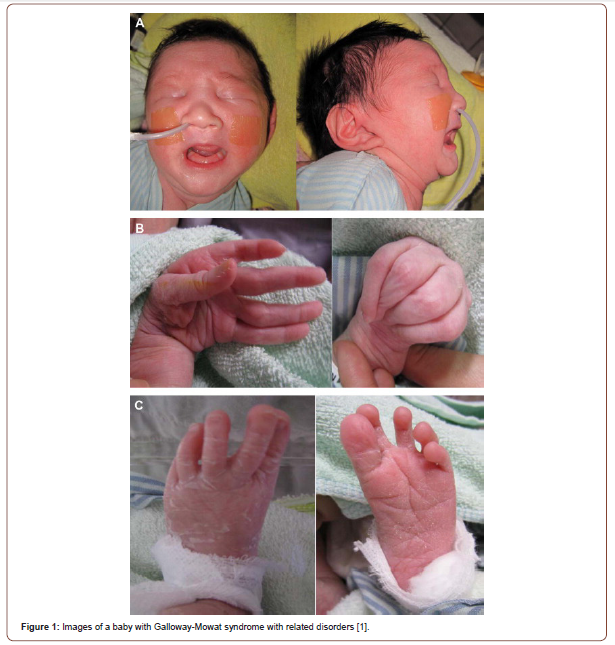
Clinical Signs and Symptoms of Galloway-Mowat Syndrome
Although researchers have been able to describe a syndrome with characteristic or “original” symptoms, not much is known about the disorder. Various factors, including the small number of cases identified, the lack of large clinical trials, and the possibility of genetic causes other than the WDR73 gene and other genetic factors that have not yet been discovered, can contribute to this syndrome. Some researchers believe that Galloway-Mowat syndrome represents a clinically and genetically heterogeneous group, meaning disorders that have different causes (e.g., different aberrant genes), but lead to similar symptoms or spectrum of symptoms. Be. As a result, the specific symptoms present and the overall severity can vary greatly from person to person [1,3] (Figure 2).
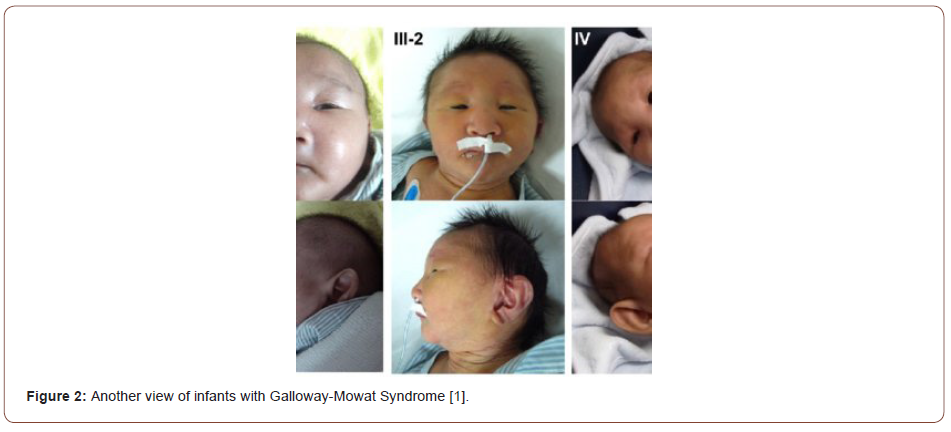
It is important to note that people with the disease will not have all of the symptoms discussed below, and each person with the disease can be unique. Galloway-Mowat syndrome can, in some cases, be associated with life-threatening complications early in life [1,4].
Physical characteristics may include abnormalities of the head and face (skull and face), including microcephaly, which may be present at birth or develop shortly after birth, abnormally narrow forehead, and abnormal jaw bones (micrognathia).). The head may appear flat at the top (top) and back (obstruction). There may also be abnormalities that affect the eye, such as visual atrophy, a condition characterized by damage to the optic nerve that carries information from the retina to the brain [1,4] (Figure 3).
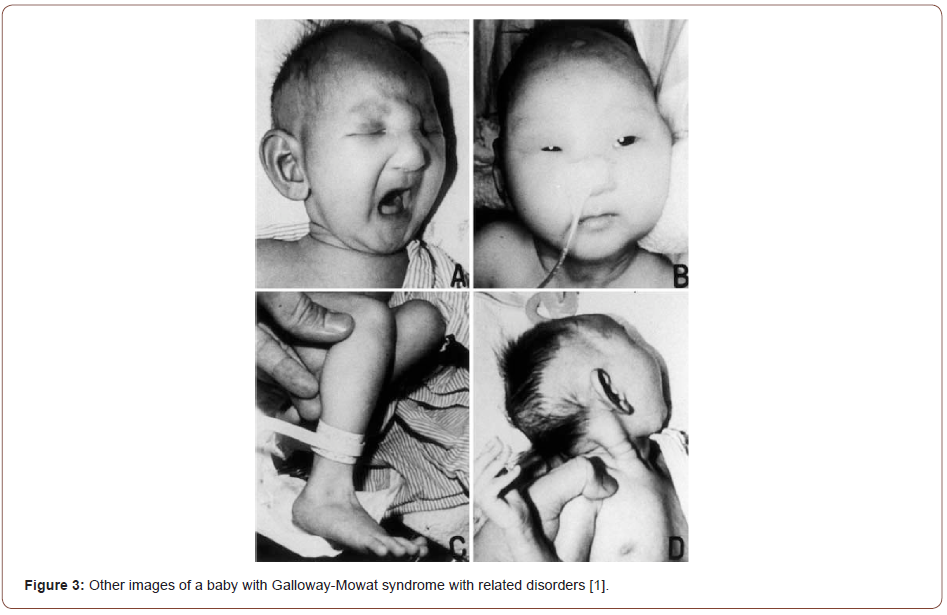
In some babies, a portion of the stomach may protrude through an abnormal opening through the esophagus that passes through the diaphragm (hiatal hernia). As a result, the muscle that joins the esophagus and stomach (the junction of the esophagus) may not function properly, and there may be low pressure or improper loosening of the muscle fiber band that closes the esophageal opening (lower esophageal sphincter). This allows the acidic contents of the stomach to return to the esophagus (gastric reflux). This gastroesophageal reflux disease can cause children with sputum or recurrent vomiting. In some cases, the vomiting may be particularly severe (severe vomiting). Affected babies may not grow because they are losing the necessary calories and nutrients. Gastric reflux can also cause inflammation of the esophagus (esophagitis). Laryngeal occlusion is also due to sudden and severe laryngeal contractions, which are an inflammatory condition of the lungs caused by food particles entering the airways (aspiration pneumonia), or additional respiratory complications may occur in this syndrome [1,5].
Affected infants may also have kidney abnormalities that may be present from birth (congenital) or do not develop until late childhood. Kidney function gradually deteriorates, and the kidneys excrete large amounts of protein through urine (nephrotic syndrome), especially albumin protein (albuminuria). This means that children with abnormally low levels of albumin in the blood (hypoalbuminemia) also have anemia, weakness, accumulation of fluid in the abdominal cavity (ascites), or abnormal accumulation of fluid between the layers of tissue under the skin (edema). Especially around the eye sockets (swelling around the pupil). Parts of the body, such as the ankles, become swollen, and the kidneys eventually lose the ability to excrete wastes through urine, regulate salt and water balance in the body, and perform other vital functions (kidney failure). People with standard treatments for nephrotic syndrome and its symptoms do not respond, and the progression of the disease worsens with concomitant infections such as viral colds and flu [1,6].
Infants with Galloway-Mowat syndrome may also show a variety of central nervous system disorders. Neurological symptoms can precede the occurrence of kidney abnormalities. Affected babies may have an abnormally small brain (microcephaly) at birth, or it may grow older. The cerebellum, which controls coordination of movement, may be smaller than normal. The outer layer of the brain (cortex), which is responsible for conscious movement and thought, is usually made up of several deep folds (gyrus) and grooves (sulci). However, in some affected infants, the outer layer of the brain may have folds that are abnormally small (microgeria), or there may be more wrinkles than normal (purity of the giria). In other cases, the wrinkle may be absent (agyria) or incompletely formed (lysencephaly). As a result, the brain may have a smooth surface [1,7] (Figure 4).
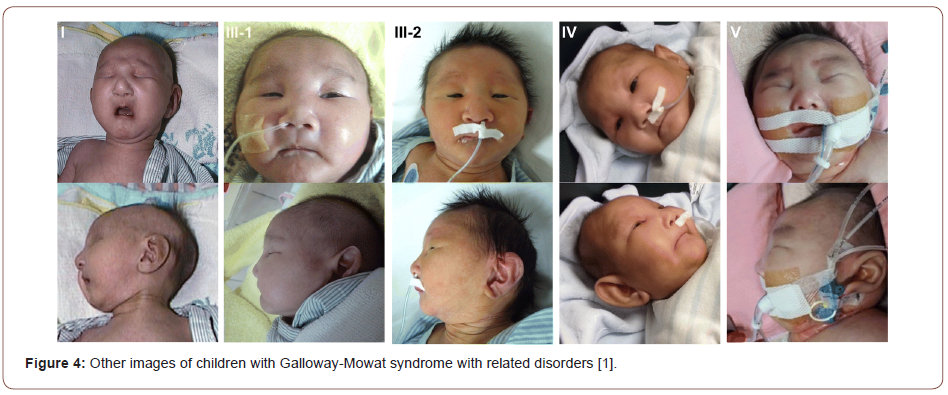
Nervous features may include a lack of response to environmental stimuli or cases of uncontrolled electrical disturbances in the brain that may cause seizures, spasms, or other symptoms (seizures). Neuromuscular abnormalities may include muscle contraction (hypotension), poor ability to control head movements or inability to control hand, foot or eye movements, muscle spasms, and abnormal limb movements (dystonic and blind movements). Developmental abnormalities in infants and children with the disorder may include the inability to perform some normal motor skills for their age (e.g., sitting, crawling, walking, and other developmental milestones) and profound delays in acquiring the skills needed for Be in harmony. Be muscular and mental activity (psychomotor retardation). Severe intellectual disability is also common [1,8].
Additional symptoms and physical characteristics have been described in specific cases, including skeletal abnormalities such as immature nails, ankles, toes that are bent or fixed (compact ductal), shortening of muscle tissue, and tendons in the joint. , Which causes the joint to bend, or a bent position (flexion contractions), deformity of the central spinal canal, stunted growth of the thyroid or adrenal glands, replacement of diaphragmatic muscle tissue with fibroelastic tissue that can cause diaphragmatic displacement. In addition, in a few specific cases, a brain abnormality known as Dundee Walker (DWM) abnormality has been reported [1,8].
People with Galloway-Mawat syndrome appear to be caused by a mutation in the WDR73 gene, which is located in the long arm of chromosome 15 at 15q25.2. Patients with this syndrome have a main set of features that include: progressive microcephaly, cerebellar atrophy (gradual shrinkage of the cerebellum), whole-body hypotension, severe / profound mental disorder and intellectual disability, and progressive nephrotic syndrome. Seizures of various types that are difficult to control and dystonia and unbalanced movements are frequently observed in this syndrome [1,8].
Etiology of Galloway-Mowat Syndrome
In 2014, it was shown that Galloway-Mowat syndrome is caused by changes (mutations) in the WDR73 gene in a subset of cases. Genes provide the instructions for making proteins that play a key role in many bodily functions. When a gene mutation occurs, the protein product may be defective, inefficient, or lacking. Depending on the function of the particular protein, this can affect many systems of the body [1,9] (Figure 5).

Galloway-Mowat syndrome follows an autosomal recessive inherited pattern. Therefore, two copies of the WDR73 mutant gene (one from the father and the other from the mother) are required to cause the syndrome, and the chance of having a child with the autosomal recessive syndrome is 25% for each possible pregnancy [1,9]. Although the WDR73 gene has been shown to cause Galloway- Mowat syndrome, researchers believe that additional genes that have not yet been identified may cause the disorder (genetic heterogeneity) in other cases [1,9] (Figure 6).
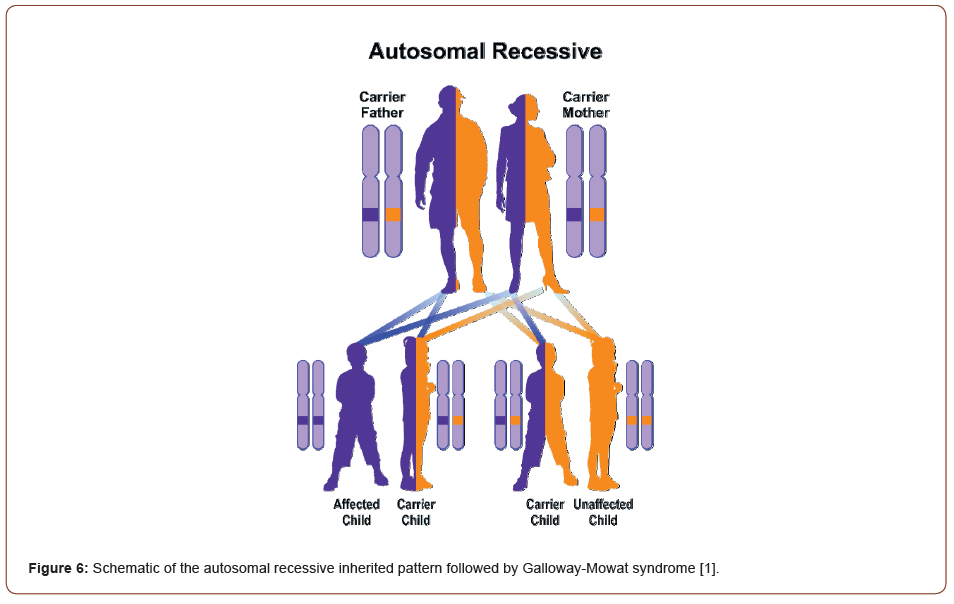
Frequency of Galloway-Mowat Syndrome
Galloway-Mowat syndrome affects men and women in equal numbers. More than 70 cases have been reported in the medical literature. Because cases may not be diagnosed correctly or not diagnosed at all, it is difficult to determine the true prevalence of Galloway-Mowat syndrome in the general population. There is a high-frequency mutation of the founder of WDR73 in the old Amish population, which leads to an increase in the frequency of Galloway- Mowat syndrome in this population [1,10].
Disorders associated with Galloway-Mowat Syndrome
Due to the variety of symptoms and the occurrence of Galloway- Mowat syndrome, there are many disorders that can have symptoms of overlap or expression of a similar disease [1,10].
Diagnosis of Galloway-Mowat Syndrome
Galloway-Mowat syndrome can be diagnosed after birth (postpartum) with a thorough clinical evaluation, specific physical findings, specialized tests, imaging techniques, and genetic testing. Several of the main symptoms associated with this disorder, such as nephrotic syndrome and head size smaller than normal (microcephaly), may be evident from birth [1,10].
Clinical Trial
In affected infants, the symptoms associated with nephrotic syndrome may be evident in the days, weeks, months, or in some cases, years after birth. Urine analysis may show traces of blood (hematuria) and abnormal levels of protein (proteinuria), especially albumin (albuminuria), in the urine. Additional laboratory studies may show abnormally low levels of albumin in a person’s blood (hypoalbuminemia). These findings, along with anemia and abnormal fluid accumulation that causes swelling (edema), may be a diagnosis of nephrotic syndrome. Accurate imaging of the brain, such as magnetic resonance imaging (MRI), may show certain brain abnormalities seen in Galloway-Mowat syndrome, such as the cerebellum [1,11].
Therapeutic routes of Galloway-Mowat Syndrome
Treatment is for specific symptoms that are specific to each individual and may require the coordinated efforts of a team of specialists, including pediatricians, kidney specialists (nephrologists), gastroenterologists, neurologists, surgeons, physiotherapists, or other health care professionals may need to work together to ensure a consistent and comprehensive approach to treatment. Genetic counseling may be helpful for sufferers and their families [1,11]. Treatment for nephrotic syndrome may include a low-sodium, low-protein diet, injections of albumin and vitamins, thyroid, and mineral supplements. Edema associated with nephrotic syndrome may be treated with medications that cause urination (diuretics). Medication may also include antibiotics to help fight the infection. Treatment with corticosteroids or immunosuppressive drugs has not been effective for nephrotic syndrome associated with Galloway- Mowat syndrome. In cases that lead to kidney failure, hemodialysis may be needed to remove excess waste from the blood. Dialysis is a method that uses a device to perform some kidney function, during which waste products are filtered out of the bloodstream, helping to control blood pressure and help maintain proper levels of essential chemicals such as potassium. The final stage of kidney disease is irreversible, so people need lifelong dialysis or kidney transplant treatment [1,11].
Early intervention services are very important in ensuring that potential children reach their full potential. Special services that may be helpful include special medical education, physiotherapy, speech therapy, or other medical, social, or occupational services [1,11].
Additional treatment for this disorder is specific and supportive symptoms. Specific symptoms associated with Galloway-Mowat syndrome are treated according to common and accepted guidelines. Surgery may be needed for some symptoms, such as a hiatal hernia. Treatment with anticonvulsants (antiepileptics) may be prescribed to people who are having seizures to help prevent, reduce, or control seizures. Because sufferers may take other medications that may prohibit the use of certain anticonvulsants (drug interactions), each patient’s case must be fully coordinated by the physician team to determine the most appropriate treatment for each group of symptoms. To be determined [1,11].
Discussion and Conclusion
Galloway-Mowat syndrome is a very rare genetic disorder characterized by a variety of physical and developmental abnormalities, especially neurological abnormalities and progressive primary kidney disease. There is no specific treatment available. Epilepsy may be intractable. The nephrotic syndrome does not respond to either steroid or immunosuppressive therapy. Renal transplant may be considered for ESKD. Multidisciplinary approach is encouraged to offer a global symptomatic care.
Acknowledgment
None.
Conflicts of Interest
No Conflict of Interest.
References
- Asadi S (2021) Pathology in Medical Genetics Book, Amidi Publications, 19 Iran.
- Lifton RP, Somlo S, Giebisch GH, Seldin DW (2009) Genetics Diseases of the Kidney. Academic Press, Elsevier, Burlington MA, 106-107.
- Jinks RN, Puffenberger EG, Baple E, Brian Harding, Peter Crino, et al. (2015) Recessive nephrocerebellar syndrome on the Galloway-Mowat syndrome spectrum is caused by homozygous protein-truncating mutations of WDR73. Brain 138: 2173-2190.
- Colin E, Huynh Cong E, Mollet G, Agnes Guichet, Olivier Gribouval, et al. (2014) Loss-of-function mutations in WDR73 are responsible for microcephaly and steroid-resistant nephrotic syndrome: Galloway-Mowat syndrome. Am J Hum Genet 95(6): 637-648.
- Ben-Omran T, Fahiminiya S, Sorfazlian N, Mariam Almuriekhi, Zafar Nawaz, et al. (2014) Nonsense mutation in the WDR73 gene is associated with Galloway-Mowat syndrome. J Med Genet 52(6): 381-390.
- Ekstrand JJ, Friedman AL, Stafstrom CE (2012) Galloway-Mowat syndrome: neurologic features in two siblings pairs. Pediatr Neurol 47(2): 129-132.
- Krishnamurthy S, Rajesh NG, Ramesh A, Zenker M (2012) Infantile nephrotic syndrome with microcephaly and global developmental delay: the Galloway-Mowat syndrome. Indian J Pediatr 79(8): 1087-1090.
- Pezzella M, Yeghiazaryan NS, Veggiotti P, Alberto Bettinelli, Giovanna Giudizioso, et al. (2010) Galloway-Mowat syndrome: an early-onset progressive encephalopathy with intractable epilepsy associated to renal impairment. Two novel cases and review literature Seizure 19(2): 132-135.
- Dietrich A, Matejas V, Bitzan M, Seema Hashmi, Cathy Kiraly-Borri, et al. (2008) Analysis of genes encoding laminin beta2 and related proteins in patients with Galloway-Mowat syndrome. Pediatr Nephrol 23(10): 1779-1786.
- Niaudet P (2007) Galloway-Mowat syndrome. Orphanet Encyclopedia.
- McKusick VA (eds) Online Mendelian Inheritance in Man (OMIM). Baltimore. MD: The Johns Hopkins University, 2016, USA.
-
Shahin Asadi, Shima Dolabi, Mahtab Farrash Bashi. The Role of Mutations on Gene WDR73 in Galloway-Mowat Syndrome. Arch Biomed Eng & Biotechnol. 6(3): 2021. ABEB.MS.ID.000636. DOI: 10.33552/ABEB.2021.06.000636.
-
Galloway-Mowat syndrome, Rare genetic disorder, WDR73 gene, Neurological abnormalities, Galloway-Mowat Syndrome, Sex, Kidney, Dystonia, Nystagmus
-

This work is licensed under a Creative Commons Attribution-NonCommercial 4.0 International License.
- Abstract
- Generalities of Galloway-Mowat Syndrome
- Clinical Signs and Symptoms of Galloway-Mowat Syndrome
- Etiology of Galloway-Mowat Syndrome
- Frequency of Galloway-Mowat Syndrome
- Disorders associated with Galloway-Mowat Syndrome
- Diagnosis of Galloway-Mowat Syndrome
- Clinical Trial
- Therapeutic routes of Galloway-Mowat Syndrome
- Discussion and Conclusion
- Acknowledgement
- Conflicts of Interest
- References






